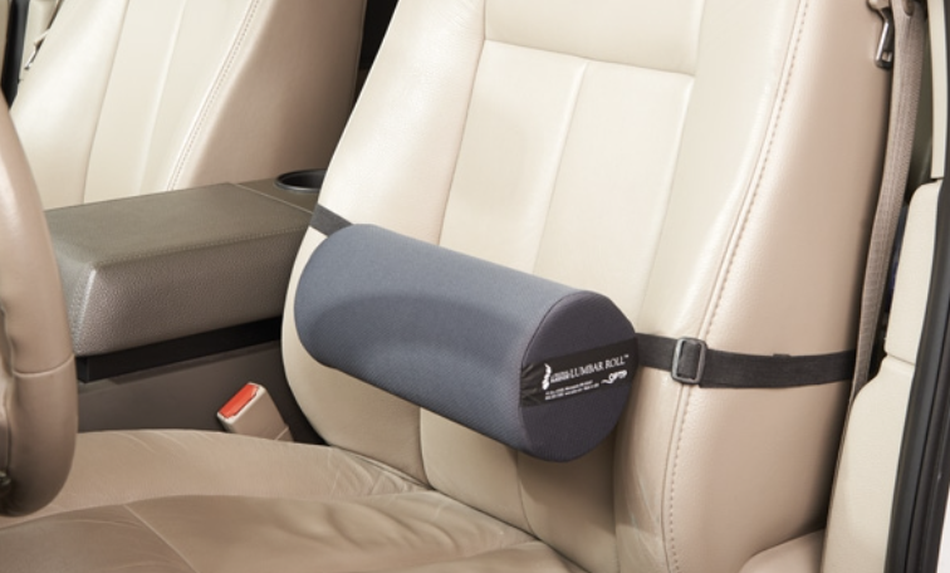Essentials Week spotlights unexpected items that make our daily lives just a little bit better.
It brings me no joy to admit that LeBron James and I probably wouldn’t have a ton to talk about at a party. But in the (very likely, if you ask me) event that we cross paths one day, I know we’ll have one common passion to discuss: lumbar support.
You may have seen photos of James — on vacation, in a huddle, posing contemplatively by the shore — with a mysterious cylinder strapped to his lower back. That cylinder is the McKenzie Lumbar Roll, a lumbar support pillow that has become one of my most prized possessions. After I slipped a disc in my lower back this spring, my physical therapist recommended that I start using one. I’d never tried an ergonomic pillow before, but it was a welcome experiment: I’d just been cleared to sit during the workday after several unpleasant weeks of standing up or lying on my stomach, and I was anxious to do so in a way that wouldn’t make my pain worse.
While it felt a little unnatural to use at first (it’s thick!), the pillow ended up being a godsend. I’d found relief in back extensions during physical therapy, and tucking the pillow behind my lower back gave me similar comfort: a robust, satisfying feeling of support, like a kind, cylindrical hand was easing my spine back into place. Even pre-injury, my desk chair at the office — which I’d liked — hadn’t been able to deliver that kind of support.

Buckle up, baby.
Image: McKenzie
So I began to channel LeBron, strapping my lumbar roll to my torso like an uncool belt bag and walking around with it on, eager to feel the sweet relief of alignment as soon as I sat down. Sometimes, I even said phrases like “that’s the stuff” as I scooted into the car or onto my chair at dinner — an earnest, dad-like habit that let me know the roll and I were in deep. Perhaps even in love.
Should you get one?
LeBron James and I both suffer from disc issues (another commonality!), so our conditions are perhaps more severe than the average office worker’s. But if you sit at a desk or in a frog-like position on the couch all day, you might appreciate extra lumbar support, too.
Soft chairs, backless chairs, and even some office chairs sorely lack support, which makes maintaining healthy posture more difficult. That’s where a lumbar support pillow can come in handy, explained Dr. Wesley Bronson, an orthopedic spine surgeon for New York’s Mount Sinai Health System. “For most people, especially for those who suffer from low back pain, I do recommend a lumbar support pillow,” he said in an email. “I know many spine specialists that keep one attached to the driver’s seat in their car and their office chair.”
The human spine normally has an “arched low back” known as lumbar lordosis, Dr. Bronson explained. (It’s possible to have excessive lordosis, but the spine should still have some.) Sitting with poor posture — that is, hunched forward with a flexed spine — can “diminish” that arch, putting more stress on the lower back and potentially leading to pain. A lumbar roll, on the other hand, helps maintain the arch, making it easier to sit healthily. (Positioning the pillow correctly is key, though: This vaguely creepy video will show you how.)
A few caveats
There are a lot of lumbar rolls out there, many of which are well-reviewed, but LeBron’s and my lumbar roll is affiliated with the McKenzie method of physical therapy. My physical therapist favors this approach, and it was the right one for my particular condition, but that doesn’t mean it’s right for everyone — nor do you have to go all-in on McKenzie to enjoy a lumbar roll’s benefits. (In fact, you should not begin any medical regimen without consulting a physician.) Using a roll also isn’t for everyone, necessarily. If you already sit with your lumbar spine considerably extended, it may even end up doing harm, explained Dr. Theresa Marko, an orthopedic clinical specialist in physical therapy who practices in New York City.
“Sitting in too much extension compresses your vertebrae, possibly pinching the nerves and also might cause your muscles to shorten in this position,” she said. “Then when you go to move, you have difficulty because they are tight from being in this constant shortened position.” She also cautions against using a lumbar roll if you have issues with nerve root compression. (Dr. Marko is not against lumbar pillows in general, though, especially if you spend a lot of time in a chair that lacks support.)
These days, I supplement the pillow with other practices that make my back feel better: stretching, taking frequent breaks, doing lumbar exercises like press-ups, and working to keep my core strong so I can hold myself up effectively. The pillow shines mostly on long car rides — when I don’t have the luxury of adjusting my posture frequently — and during periods of more acute pain.
However, I imagine that my post-COVID travel will have a distinctly LeBron vibe: I plan to strap my lumbar roll to my back for entire days, ready for whatever awful seating comes my way. Maybe we’ll run into each other on a beach somewhere, point at each other’s strapped-on back pillows and adequately S-shaped spines, and share a little laugh, nod at each other in recognition. I feel like that will probably happen.
